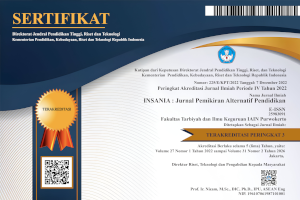Mengurangi Pengangguran Terdidik Melalui Pendidikan Kewirausahaan Yang Berpotensi Pencegahan Korupsi
DOI:
https://doi.org/10.24090/insania.v22i1.1509Keywords:
Educated Unemployment, Entrepreneurship Education, Corruption PreventionAbstract
Abstract: The inequality between educated job seekers and available employment causes a lot of unemployment. This is exacerbated by the number of universities that annually issue new graduates that make the number of educated unemployed. High unemployment causes the community is not able to maximize their welfare. The success of economic development can be seen from the high economic growth. Increased economic growth is expected to improve the welfare of the community and increase human development by Indicator of Index Human Development (HDI). It takes the government seriousness in addressing issues of human development improvement by reducing educated unemployment through entrepreneurial education with the potential to prevent corruption. Corruption in Indonesia requires extra thought for the government to overcome it. In accordance with the values contained in Entrepreneurship education, the government seeks to direct the Indonesian society from "finding a job" to "creating job" so that will affects in the prevention of corruption. Keywords: Educated Unemployment, Entrepreneurship Education, Corruption Prevention.Downloads
References
Arsyad, Lincolin. 2010. Ekonomi Pembangunan. Yogyakarta: UPP STIM YKPN.
Atmasasmita, H. Romli. 2013. “Teori Dan Kapita Selekta Kriminologi.†Jakarta: Sinar Grafika.
Baharuddin, M. 1980. Tuna Karya/ Pengangguran Indonesia, masalah Penanggulangan: Yayasan kesejahteraan Keluarga Pemuda.
BAPPENAS RI, 2012. Public Good Governance: Sebuah Paparan Singkat. Jakarta: Bappenas RI.
Buchari, Alma, 2009.Kewirausahaan. Bandung:Alfabeta.
De Jong, J., dan S. Wennekers. 2008.Conceptualizing entrepreneurial employee behaviour, Intrapreneurship, H200802,EIM, Netherlands.
Ginting S, Charisma Kuriata, Irsad Lubis, Dan Kasyful Mahalli. 2008. “Pembangunan Manusia Di Indonesia Dan Faktor-Faktor Yang Mempengaruhinyaâ€. Jurnal Perencanaan & Pengembangan Wilayah, Vol.4, No.1, Agustus 2008. Hal 17-24.
https://www.bps.go.id/Subjek/view/id/26#subjekViewTab2. Diakses 18 Oktober 2017.
Idris, dan Ramel Yanuarta. 2007. Bahan Ajar: Ekonomi Sumber Daya Manusia. FE UNP.
Kasmir, 2006. Kewirausahaan. Jakarta: Raja Grafindo Persada.
Mankiw, N. Gregory.2006. Makroekonomi edisi ke-6. Jakarta : Erlangga.
Meredith, G.G., R. E., dan Nelson, A. P. Neck. 2005. Kewirausahaan, Teori dan Praktik, Jakarta: Penerbit PPM.
Murdjianto dan Aliaras Wahid. 2006. Membangun Karakter Dan Kepribadian Kewirausahaan. Yogyakarta: Graha Ilmu.
Naisbitt, J. dan Aburdene, P. 1979. Re-inventing the Corporation, New York: Warner Books Inc.
Prasetyo, Eko. 2009. Fundamental Makro Ekonomi. Yogyakarta: Beta Offset.
Prasojo, Eko, Teguh Kurniawan, Defny Holidin, 2007. Refomasi dan Inovasi Birokrasi:Studi di Kabupaten PTKPNF Depdiknas.
Setiawan, S.A. 2010. Pengaruh Umur, Pendidikan, Pendapatan, Pengalaman Kerja Dan Jenis Kelamin Terhadap Lama Mencari Kerja Bagi Tenaga Kerja Terdidik Di Kota Magelang. Skripsi. Semarang: Fakultas Ekonomi Universitas Diponegoro.
Soemanto, Wasty. 2006. Pendidikan Wiraswasta. Jakarta: Bumi Aksara.
Sukirno, Sadono. 2004. Makroekonomi Teori Pengantar. Jakarta : Rajawali Pers.
Todaro, MP dan Stephen C. Smith. 2004. Pembangunan Ekonomi di Dunia Ketiga 1. Edisi ke Delapan, Jakarta: Erlangga.
UNDP. 2011. Human Development Report. New York: Oxford University Press.
Yaghoobi, N. M.,H. Salarzehi, A. Hamed,danH. Akbari. 2010. An evaluation of independent entrepreneurship obstacles in industrial SMEs. European Journal of Social Sciences: 33- 45.
Zimmerer T.W., danN. M. Scarborough. 2005. Essential of Entrepreneurship an Small Business Management, 4th, Singapore: Pearson Prentice Hall.
Downloads
Published
How to Cite
Issue
Section
License
Authors who publish with this journal agree to the following terms:
Authors retain copyright and grant the journal right of first publication with the work simultaneously licensed under a Creative CommonsAttribution-ShareAlike License that allows others to share the work with an acknowledgment of the work's authorship and initial publication in this journal.
Authors are able to enter into separate, additional contractual arrangements for the non-exclusive distribution of the journal's published version of the work (e.g., post it to an institutional repository or publish it in a book), with an acknowledgment of its initial publication in this journal.
Authors are permitted and encouraged to post their work online (e.g., in institutional repositories or on their website) prior to and during the submission process, as it can lead to productive exchanges, as well as earlier and greater citation of published work (See The Effect of Open Access).








